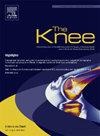In vivo kinematics during step ascent: Changes to the knee associated with osteoarthritis
IF 1.6
4区 医学
Q3 ORTHOPEDICS
引用次数: 0
Abstract
Background
Stair climbing is a kinematically demanding activity, essential for maintaining independence and quality of life, yet is often impaired in patients with knee osteoarthritis (OA). The purpose of this study was to examine differences in kinematics of a step-up movement between participants with osteoarthritis and asymptomatic controls.
Methods
Thirty participants with end-stage OA awaiting total knee arthroplasty (TKA) and twenty-eight sex and age-similar asymptomatic participants were recruited. Participants performed a step-up task which was imaged via single-plane fluoroscopy. 3-dimensional prosthesis computer-aided design models were registered to the fluoroscopy, yielding in-vivo kinematic data. Kinematic variables of position, displacement, and rate-of-change in six degrees of freedom were compared between the two groups.
Results
OA knees exhibited significantly different kinematics to asymptomatic knees during step-up. Knees with OA demonstrated a reduced terminal extension angle, inferior translation and increased internal rotation throughout the movement compared to asymptomatic. OA participants exhibited more variability in kinematic parameters compared to asymptomatic controls, reflecting the heterogeneity within OA pathology.
Conclusion
The findings of this study indicate that knee kinematics, particularly rotation, differ significantly between OA and asymptomatic knees during step-up. Optimising rotational profiles in OA knee management could help optimise patient function and inform rehabilitation and surgical protocols.
台阶上升过程中的活体运动学:与骨关节炎相关的膝关节变化。
背景:爬楼梯是一项对运动学要求很高的活动,对保持独立性和生活质量至关重要,但膝关节骨性关节炎(OA)患者的爬楼梯能力往往会受到影响。本研究的目的是检查骨关节炎患者与无症状对照组患者在上台阶运动中的运动学差异:方法:招募了 30 名等待进行全膝关节置换术(TKA)的终末期 OA 患者和 28 名性别和年龄相似的无症状患者。参试者通过单平面透视进行上台阶操作。三维假体计算机辅助设计模型与透视成像进行了注册,从而获得了体内运动学数据。对两组的位置、位移和六个自由度的变化率等运动变量进行了比较:结果:在上台阶时,有 OA 的膝关节与无症状膝关节的运动学表现明显不同。与无症状膝关节相比,患有 OA 的膝关节在整个运动过程中表现出末端伸展角度减小、下移和内旋增加。与无症状对照组相比,OA 参与者的运动学参数表现出更大的变异性,这反映了 OA 病理学的异质性:本研究结果表明,膝关节运动学,尤其是旋转,在上台阶时,OA 膝关节和无症状膝关节之间存在显著差异。在膝关节OA治疗中优化旋转曲线有助于优化患者功能,并为康复和手术方案提供参考。
本文章由计算机程序翻译,如有差异,请以英文原文为准。
求助全文
约1分钟内获得全文
求助全文
来源期刊

Knee
医学-外科
CiteScore
3.80
自引率
5.30%
发文量
171
审稿时长
6 months
期刊介绍:
The Knee is an international journal publishing studies on the clinical treatment and fundamental biomechanical characteristics of this joint. The aim of the journal is to provide a vehicle relevant to surgeons, biomedical engineers, imaging specialists, materials scientists, rehabilitation personnel and all those with an interest in the knee.
The topics covered include, but are not limited to:
• Anatomy, physiology, morphology and biochemistry;
• Biomechanical studies;
• Advances in the development of prosthetic, orthotic and augmentation devices;
• Imaging and diagnostic techniques;
• Pathology;
• Trauma;
• Surgery;
• Rehabilitation.
 求助内容:
求助内容: 应助结果提醒方式:
应助结果提醒方式:


